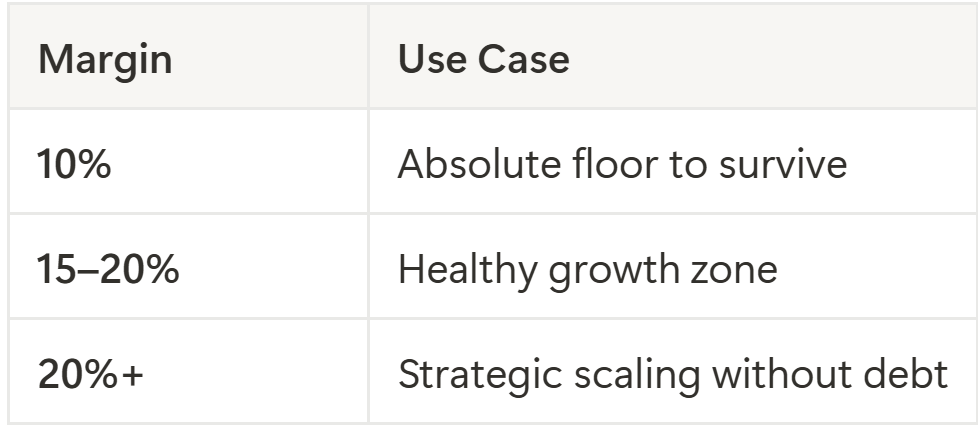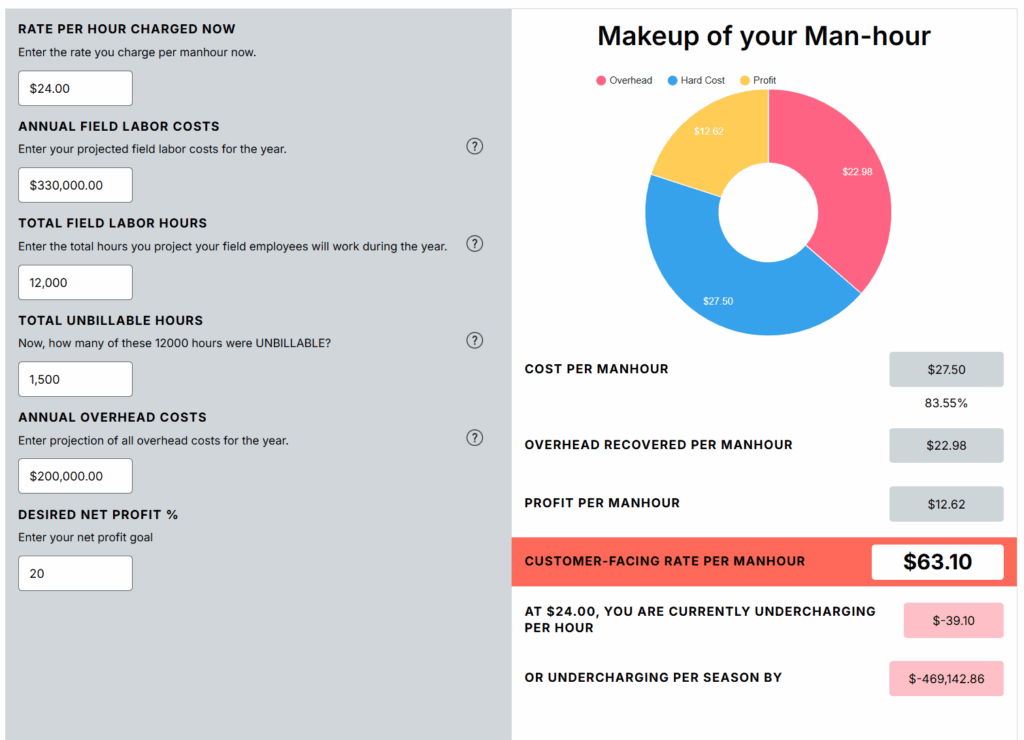Why Most Contractors Are Flying Blind
Most contractors don’t actually know their numbers.
You might be pricing jobs based on what the other guy charges, or tripling your direct costs and hoping that’s enough to make a profit.
But let’s be clear:
Hope is not a pricing strategy.
This guide will help you go from “I think I’m profitable…” to knowing your numbers cold — and pricing every job with total confidence.
Whether you’re running a $300k business or scaling past $2M, understanding your costs, setting the right profit margin, and avoiding common pricing pitfalls is key to long-term success.
🎥 Watch this first:
If you want to grow your business, get out of survival mode, and finally take control of your bottom line, you need to understand the right way to price for profit.
This guide will show you how to do that 👉 step-by-step.
Step 1: Know Your Numbers (Like, Really Know Them)
Landscape contractors commonly price jobs in one of these ways
- Mimicking competitors hourly or unit-based rates
- Tripling direct costs
Copying competitors
When you copy competitors, you assume they know what they’re doing, and are worth being copied. You are also assuming their operating costs are the same as yours.
But you have no idea if their operating and overhead costs are the same as yours, or if their business is even profitable. You end up blindly following a model that might be broken, and leaves you vulnerable to never being profitable.
Tripling direct costs
Taking material costs and tripling it is tone deaf to your overhead costs, or how much labor it’ll take to get the job done. And it gives no indication as to how much profit you’ll actually make. At best, this method is “directionally accurate” that is more suited to a “ballpark” estimate. It certainly will not produce consistent profits for you.
Bottom line: These shortcuts lead to working hard for little reward.
Remember, we can’t fix what we don’t measure. Before we talk about pricing, let’s break down the actual numbers that go into running your business.
You’ve got three main buckets:
1. Direct Costs
These are job-related costs. If you didn’t win the job, you wouldn’t have these costs.
- Labor (including payroll tax, worker’s comp, etc.)
- Materials and supplies
- Equipment fuel or wear (if billed to job)
- Subcontractors
2. Overhead Costs
These are the costs you pay whether you’re working or not.
- Admin and estimator salaries
- Office rent or utilities
- Vehicles and insurance
- Marketing, software, uniforms, etc.
- Owner’s salary (yes — you should be paying yourself like an employee)
3. Profit
This isn’t what’s left over.
Profit is what you build into your pricing so you can reinvest, grow, and have a business that supports you — not just a job that wears you out.
Step 2: Start with Your Breakeven Rate
Before you can price for profit, you need to know your breakeven on your hourly rate; aka what it costs you to pay your employees and cover the costs of operating your business each hour without losing money.
Your breakeven rate is the minimum hourly rate you need to cover all your direct and overhead costs — and make zero profit.
Formula:
Direct Costs + Overhead Allocation = Breakeven Rate
What are Direct Costs in Relation to Your Breakeven on Your Hourly Rate?
- Labor wages (including taxes & benefits)
What are Overhead Costs?
- Admin staff
- Rent & utilities
- Insurance
- Marketing
- Software
- Business owner salary
- Equipment (if shared across jobs)
Quick Example: What’s Your Breakeven?
Let’s say your crew logs 8,000 hours a year and your overhead costs total $200,000.
That’s $25/hour just to cover overhead.
Now let’s say you have $40/hour of direct costs in labor to pay your staff.
Your breakeven = $25 + $40 = $65/hour.
If you’re charging $65/hour, you’re not losing money—but you’re not making any either.👀
Want to plug in your own numbers?
Try the free hourly rate calculator and see where your breakeven lands.
🔥Your breakeven is not your price. It’s your starting point.
In the next step, we’ll build in your profit margin.
Step 3: Add Profit Margin
Once you know your breakeven, you add your profit margin.
This is what makes you the owner of a business, not the owner of a job.
Profit Margin takes you from survival to growth.
Recommended Profit Margin Targets:

Why Profit Matters:
Cash in the bank, allows you to make strategic decisions for your business, rather than making decisions based on how much money you have (or don’t have) in the bank. When you run your business decision making through the frame of how much money you have in the bank, it usually leads to scarcity mindset and reactionary decision making rather than making the best strategic decision for the long haul.
Take a moment here – to revisit your #’s in the free hourly rate calculator. Based on the profit margin you want to achieve (reference table above) – and the numbers you calculated as your hourly rate – charge below that and you’re eating into your margin. Charge above that and you’re setting yourself up for financial stability.
Many landscape contractors I work with are charging at or below their breakeven rate. Then they wonder why they can’t make it through the winter… The solution is to stop looking at what everyone else is charging and just crunch your own numbers to find the truth.

3 Ways to Increase Profit
Once you’ve nailed your pricing, here are some tips boost margins:
1. Cut overhead bloat
Audit your expenses. Drop what’s not helping you win jobs or serve customers.
2. Raise prices with confidence
You’re not a charity. If your breakeven + margin is $90/hr, charge $90/hr.…and focus on finding the right customers. You can’t sell a Porsche to a person with Kia budget.
3. Don’t Undersell Yourself
Don’t undersell yourself – once you find the truth about what your breakeven is, and where your hourly rate needs to be to ensure your are profitable, stop undercutting yourself when closing jobs. Rather than undercutting your price (and losing profit) adjust the scope of work to bring the price in line with what the client wants to spend.
Step 4: Implement Systems That Support Accurate Pricing
Once you know your rate, you need to use it consistently.
That’s where a tool like SynkedUP comes in.
SynkedUP Helps You:
- Calculate your hourly rate with real-time costs
- Build line-by-line estimates
- Track estimated vs. actual costs
- Set templates that include labor, materials, overhead, and profit margin.
- Compare job profitability after the work is done
You Deserve to Be Profitable
You work too hard to end every year wondering where the money went.
Get clear on your numbers. Price every job with confidence. Set a margin that supports your growth. And finally take the guesswork out of your business.
Because you didn’t start this company just to scrape by.
You started it to build something that lasts.
✅Ready to Start Pricing for Profit?
Want help setting up your rate and applying it across every quote and job?
We’ll show you exactly how it works inside SynkedUP.
Let’s make sure the next job you win actually puts money in the bank.
Taking material costs and tripling it is tone deaf to your overhead costs, or how much labor it’ll take to get the job done. And it gives no indication as to how much profit you’ll actually make. At best, this method is “directionally accurate” that is more suited to a “ballpark” estimate. It certainly will not produce consistent profits for you.

Weston Zimmerman
CEO and co-founder








